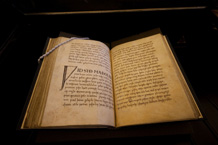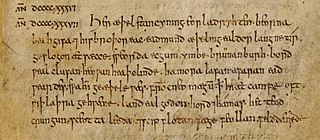Related Research Articles

Beowulf is an Old English epic poem in the tradition of Germanic heroic legend consisting of 3,182 alliterative lines. It is one of the most important and most often translated works of Old English literature. The date of composition is a matter of contention among scholars; the only certain dating is for the manuscript, which was produced between 975 and 1025. Scholars call the anonymous author the "Beowulf poet". The story is set in pagan Scandinavia in the 6th century. Beowulf, a hero of the Geats, comes to the aid of Hrothgar, the king of the Danes, whose mead hall in Heorot has been under attack by the monster Grendel. After Beowulf slays him, Grendel's mother attacks the hall and is then defeated. Victorious, Beowulf goes home to Geatland and becomes king of the Geats. Fifty years later, Beowulf defeats a dragon, but is mortally wounded in the battle. After his death, his attendants cremate his body and erect a barrow on a headland in his memory.
Old English literature refers to poetry and prose written in Old English in early medieval England, from the 7th century to the decades after the Norman Conquest of 1066, a period often termed Anglo-Saxon England. The 7th-century work Cædmon's Hymn is often considered as the oldest surviving poem in English, as it appears in an 8th-century copy of Bede's text, the Ecclesiastical History of the English People. Poetry written in the mid 12th century represents some of the latest post-Norman examples of Old English. Adherence to the grammatical rules of Old English is largely inconsistent in 12th-century work, and by the 13th century the grammar and syntax of Old English had almost completely deteriorated, giving way to the much larger Middle English corpus of literature.

A scop was a poet as represented in Old English poetry. The scop is the Old English counterpart of the Old Norse skald, with the important difference that "skald" was applied to historical persons, and scop is used, for the most part, to designate oral poets within Old English literature. Very little is known about scops, and their historical existence is questioned by some scholars.

The Exeter Book, also known as the Codex Exoniensis or Exeter Cathedral Library MS 3501, is a large codex of Old English poetry, believed to have been produced in the late tenth century AD. It is one of the four major manuscripts of Old English poetry, along with the Vercelli Book in Vercelli, Italy, the Nowell Codex in the British Library, and the Junius manuscript in the Bodleian Library in Oxford. The book was donated to what is now the Exeter Cathedral library by Leofric, the first bishop of Exeter, in 1072. It is believed originally to have contained 130 or 131 leaves, of which the first 7 or 8 have been replaced with other leaves; the original first 8 leaves are lost. The Exeter Book is the largest and perhaps oldest known manuscript of Old English literature, containing about a sixth of the Old English poetry that has survived.

"Wulf and Eadwacer" is an Old English poem of famously difficult interpretation. It has been variously characterised, (modernly) as an elegy, (historically) as a riddle, and as a song or ballad with refrain. The poem is narrated in the first person, most likely by female speaker. Because the audience is given so little information about her situation, some scholars argue the story was well-known, and that the unnamed speaker corresponds, for example, to Signý or that the characters Wulf and Eadwacer correspond to Theoderic the Great and his rival Odoacer. The poem's only extant text is found at folios 100v-101r in the tenth-century Exeter Book, alongside certain other texts to which it possesses qualitative similarities.
The Seafarer is an Old English poem giving a first-person account of a man alone on the sea. The poem consists of 124 lines, followed by the single word "Amen". It is recorded only at folios 81 verso – 83 recto of the tenth-century Exeter Book, one of the four surviving manuscripts of Old English poetry. It has most often, though not always, been categorised as an elegy, a poetic genre commonly assigned to a particular group of Old English poems that reflect on spiritual and earthly melancholy.

Beowulf is a legendary Geatish hero in the eponymous epic poem, one of the oldest surviving pieces of English literature.

Modthryth, Thryth, and Fremu are reconstructed names for a character who figures as the queen of King Offa in Beowulf.

"On Translating Beowulf" is an essay by J. R. R. Tolkien which discusses the difficulties faced by anyone attempting to translate the Old English heroic-elegiac poem Beowulf into modern English. It was first published in 1940 as a preface contributed by Tolkien to a translation of Old English poetry; it was first published as an essay under its current name in the 1983 collection The Monsters and the Critics, and Other Essays.
Andreas is an Old English poem, which tells the story of St. Andrew the Apostle, while commenting on the literary role of the "hero". It is believed to be a translation of a Latin work, which is originally derived from the Greek story The Acts of Andrew and Matthew in the City of Anthropophagi, dated around the 4th century. However, the author of Andreas added the aspect of the Germanic hero to the Greek story to create the poem Andreas, where St. Andrew is depicted as an Old English warrior, fighting against evil forces. This allows Andreas to have both poetic and religious significance.
"The Husband's Message" is an anonymous Old English poem, 53 lines long and found only on folio 123 of the Exeter Book. The poem is cast as the private address of an unknown first-person speaker to a wife, challenging the reader to discover the speaker's identity and the nature of the conversation, the mystery of which is enhanced by a burn-hole at the beginning of the poem.

Exodus is the title given to an Old English alliterative poem in the 10th century Junius manuscript. Exodus is not a paraphrase of the biblical book, but rather a re-telling of the story of the Israelites' flight from Egyptian captivity and the Crossing of the Red Sea in the manner of a "heroic epic", much like Old English poems Andreas, Judith, or even Beowulf. It is one of the densest, most allusive and complex poems in Old English, and is the focus of much critical debate.

The "Battle of Brunanburh" is an Old English poem. It is preserved in the Anglo-Saxon Chronicle, a historical record of events in Anglo-Saxon England which was kept from the late ninth to the mid-twelfth century. The poem records the Battle of Brunanburh, a battle fought in 937 between an English army and a combined army of Scots, Vikings, and Britons. The battle resulted in an English victory, celebrated by the poem in style and language like that of traditional Old English battle poetry. The poem is notable because of those traditional elements and has been praised for its authentic tone, but it is also remarkable for its fiercely nationalistic tone, which documents the development of a unified England ruled by the House of Wessex.

Anglo-Saxon riddles are a significant genre of Anglo-Saxon literature. The riddle was a major, prestigious literary form in early medieval England, and riddles were written both in Latin and Old English verse. The pre-eminent composer of Latin riddles in early medieval England was Aldhelm, while the Old English verse riddles found in the tenth-century Exeter Book include some of the most famous Old English poems.
A number of royal genealogies of the Anglo-Saxon kingdoms, collectively referred to as the Anglo-Saxon royal genealogies, have been preserved in a manuscript tradition based in the 8th to 10th centuries.
John Richard Clark Hall was a British scholar of Old English, and a barrister. In his professional life, Hall worked as a clerk at the Local Government Board in Whitehall. Admitted to Gray's Inn in 1881 and called to the bar in 1896, Hall became principal clerk two years later.

Beowulf: A New Verse Translation is a verse translation of the Old English epic poem Beowulf into modern English by the Irish poet and playwright Seamus Heaney. It was published in 1999 by Farrar, Straus, and Giroux and Faber and Faber, and won that year's Whitbread Book of the Year Award.
Adrian and Ritheus is an Old English prose literary text preserved in British Library manuscript Cotton Julius A ii, fols 137v-140. It consists of a dialogue of forty-eight formulaic questions and answers between the titular 'Adrianus' and 'Ritheus'. Adrianus interrogates Ritheus using the formulaic expression Saga me ; Ritheus responds using the formulaic Ic þe secge. The nature of the questions posed varies between the factual and the enigmatic, but the style of questioning is "usually short and to the point".
Leonard Neidorf is an American philologist who is Professor of English at Nanjing University. Neidorf specializes in the study of Old English and Middle English literature, and is a known authority on Beowulf.

The difficulty of translating Beowulf from its compact, metrical, alliterative form in a single surviving but damaged Old English manuscript into any modern language is considerable, matched by the large number of attempts to make the poem approachable, and the scholarly attention given to the problem.
References
- ↑ Anlezark, Daniel (2009). The Old English dialogues of Solomon and Saturn. D.S. Brewer. pp. vii. ISBN 978-1-84615-750-9. OCLC 1350354398.
- ↑ Cross, James E.; Hill, Thomas D. (1982). The Prose Soloman and Saturn and Adrian and Ritheus. Toronto: University of Toronto Press. p. 7. ISBN 0-8020-5472-2.
- ↑ J. S. Ryan "Othin in England: Evidence from the Poetry for a Cult of Woden in Anglo-Saxon England Folklore, Vol. 74, No. 3. (Autumn, 1963), pp. 460-480. See p.476.
- ↑ Patrick O'Neill, "On the date, Provenance and Relationship of the ‘Solomon and Saturn’ Dialogues", Anglo-Saxon England 26 (1997), 139-168.
- ↑ Anlezark 2009, p. vii.
- ↑ Andy Orchard, Pride and Prodigies, pp. 82-5
- ↑ Anlezark, "Poisoned Places"
- ↑ Major, "Saturn's First Riddle"
- ↑ Menner, "The Vasa Mortis Passage"
- ↑ Cilluffo, "Mirabilia Ags."
- ↑ Kathryn Powell Archived 2008-04-13 at the Wayback Machine , "Orientalist Fantasy in the Poetic Dialogues of Solomon and Saturn", Anglo-Saxon England 34 (2005), 117-143 Cambridge University Press